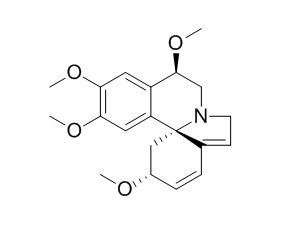Erythristemine
(+)-Erythristemine shows moderate toxicity to brine shrimp (LC50 23 ppm) and moderate (IC50=86microg/ml) radical scavenging properties against stable 2,2-diphenyl-1-picrylhy--drazyl (DPPH) radical.
Inquire / Order:
manager@chemfaces.com
Technical Inquiries:
service@chemfaces.com
Tel:
+86-27-84237783
Fax:
+86-27-84254680
Address:
1 Building, No. 83, CheCheng Rd., Wuhan Economic and Technological Development Zone, Wuhan, Hubei 430056, PRC
Providing storage is as stated on the product vial and the vial is kept tightly sealed, the product can be stored for up to
24 months(2-8C).
Wherever possible, you should prepare and use solutions on the same day. However, if you need to make up stock solutions in advance, we recommend that you store the solution as aliquots in tightly sealed vials at -20C. Generally, these will be useable for up to two weeks. Before use, and prior to opening the vial we recommend that you allow your product to equilibrate to room temperature for at least 1 hour.
Need more advice on solubility, usage and handling? Please email to: service@chemfaces.com
The packaging of the product may have turned upside down during transportation, resulting in the natural compounds adhering to the neck or cap of the vial. take the vial out of its packaging and gently shake to let the compounds fall to the bottom of the vial. for liquid products, centrifuge at 200-500 RPM to gather the liquid at the bottom of the vial. try to avoid loss or contamination during handling.
Thorac Cancer.2023, 14(21):2007-2017.
Phytomedicine.2019, 62:152962
Phytochemistry Letters2015, 243-247
Journal of Apiculture2023.38(3):249-254.
Molecules.2017, 22(12)
J. of The Korean Society of Food Culture2017, 144-149
Front Immunol.2017, 8:1542
Sci Rep.2016, 6:25094
Antioxidants (Basel).2022, 11(8):1471.
Vietnam Journal of Science2022, 64(2), 69-75.
Related and Featured Products
Phytochemistry. 2004 May;65(10):1397-404.
Erythrinaline alkaloids from the flowers and pods of Erythrina lysistemon and their DPPH radical scavenging properties.[Pubmed:
15231413]
(+)-Erythristemine (14) was found distributed in most of the plant parts investigated.
METHODS AND RESULTS:
Preliminary work on the crude chloroform/methanol (1:1) showed moderate toxicity to brine shrimp (LC50 23 ppm) and moderate (IC50 86 microg/ml) radical scavenging properties against stable 2,2-diphenyl-1-picrylhydrazyl (DPPH) radical. The DPPH radical scavenging properties of the isolated compounds were assessed using TLC autographic and spectrophotometric assays whereupon only compounds 11 (1 microg; 90 microg/ml) and 12 (0.1 microg; 160 microg/ml) showed any notable activity.
CONCLUSIONS:
It appears the two compounds are slow reacting and do not reach steady state conditions within the standard half an hour time frame but only seemed to have reached steady state conditions after 4 h.



